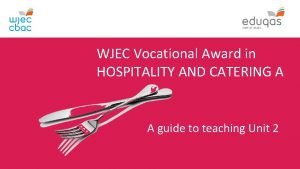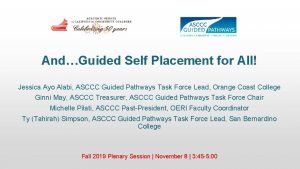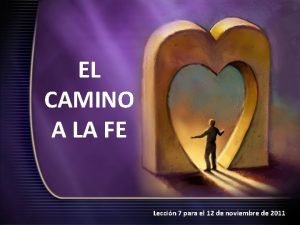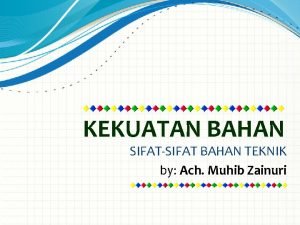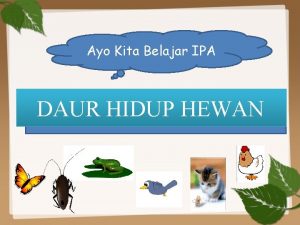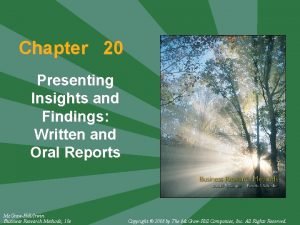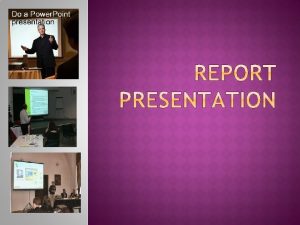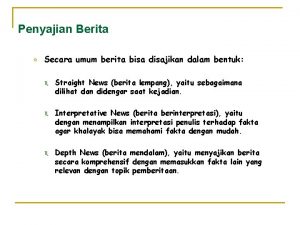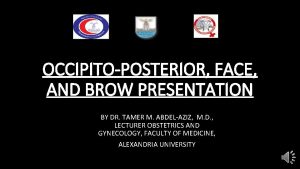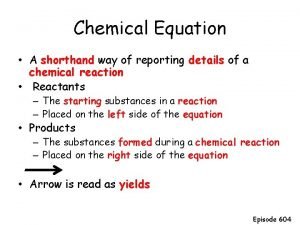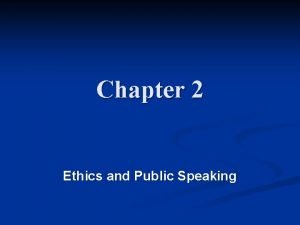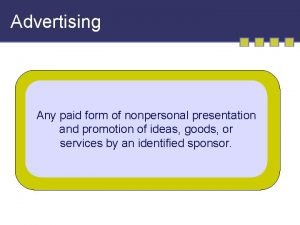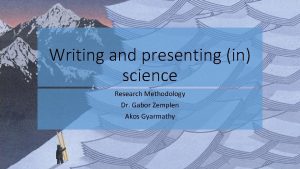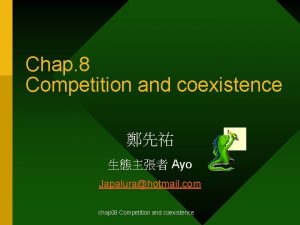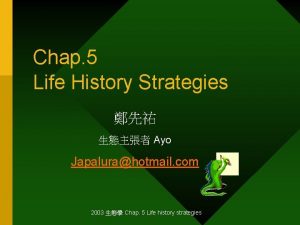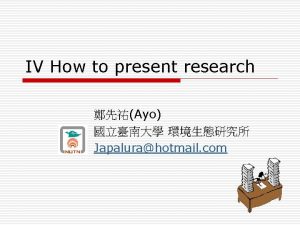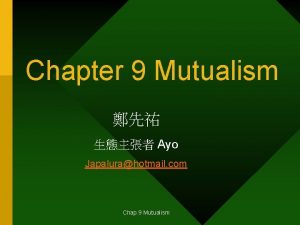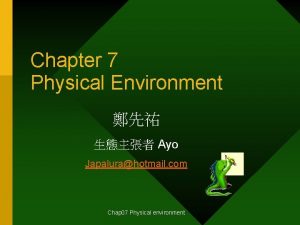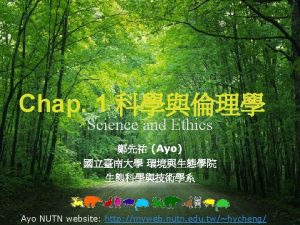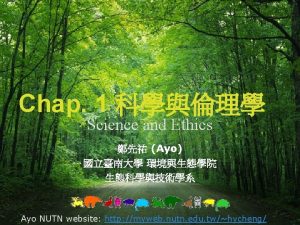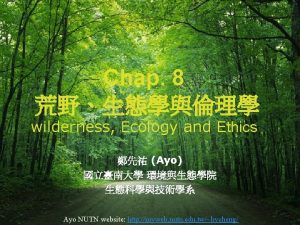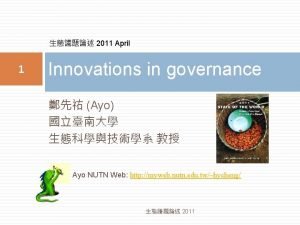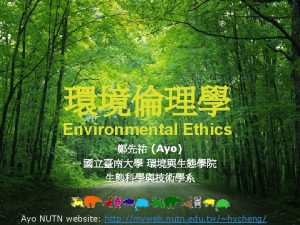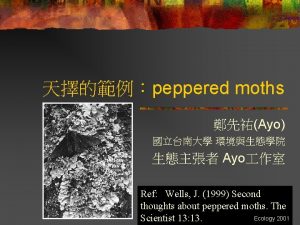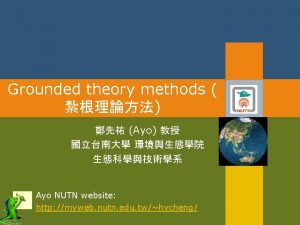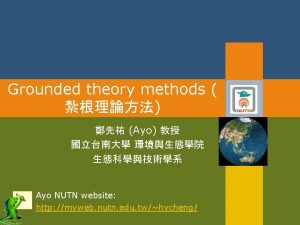Planning Proposing and Presenting Science Ayo Japalurahotmail com





















- Slides: 21

行為科學研究法 Planning, Proposing, and Presenting Science 鄭先祐 (Ayo) 國立臺南大學 環境生態研究所 Japalura@hotmail. com

Textbook o o o Hailman, J. P. & K. B. Strier (2006) Planning, Proposing, and Presenting Science Effectively. 2 nd ed. Cambridge University Press. 金字塔原理:思考、寫作、解決問題的邏輯方法。 (The Minto Pyramid Principle: Logic in writing, thinking and problem solving) (陳筱 、 羅若蘋 譯) (經濟新潮社) 參考書目: n n 簡報技術圖解 (趙韻毅 譯) (商周出版) Mayr, E. (1982) The growth of biological thought: 2 diversity, evolution, and inheritance. The Belknap Press of Harvard University Press.

課程 o o o o 一、如何規劃研究 (plan research) 二、如何寫研究計畫書 (write a research proposal) 三、如何寫研究報告 (write a research report) 四、如何發表報告 (present research) 五、如何寫個人簡歷 (curriculum vitae) 六、如何寫清楚 (write clearly) 七、倫理的考量 (Ethics considerations) 八、個案討論 (Case studies) n 金字塔原理 3

Planning, Proposing, and Presenting science effectively o 1. 2. 3. 4. 5. o A guide for graduate students and researchers How to plan research How to write a research proposal How to write a research report How to present research How to write a CV Appendixes n n How to write clearly Ethics considerations 4

Preface o o 生物科學的教學,與大部分的科學相同,都 著重於技術與學理的學習。 如何成為一個成功的研究者,往往被忽略。 n 譬如:how to plan a study adequately, secure research funds effectively, present results (written and oral) clearly and interestingly, and present qualifications in a resume. 5

I How to plan research Scientific epistemology (科學認知論) Planning research (規劃研究) 鄭先祐(Ayo) 國立臺南大學 環境生態研究所 Japalura@hotmail. com

Introduction o o o The great tragedy of Science- the slaying of a beautiful hypothesis by an ugly fact. – Thomas Henry Huxley Success in science depends partly on preparedness and planning. Chance favors the prepared mind. 7

Scientific epistemology(科學認知論) o o How we accumulate knowledge and understanding through science Science as process and product Induction (歸納) Model (模式) hypothesis→ theory → law Prediction (預測) Decision (決定) Comparison (比較) Deduction (推論) Data (數據) Fig. 1. 1 the epistemological cycle Observation (觀察) 8

Planning research (規劃研究) 1. 2. 3. 4. 5. 6. o Finding a problem (找到問題) Formulating a model (建構模式) Devising testable predictions (可驗證的預測 ) Comparative studies (比較研究) Interrelationship between field and laboratory(野地與實驗室) Other aspects (其他方面) Implementing the plan (落實規劃) 9

Planning research (規劃研究) o o o Planning is the essence of success in science Especially important for the field biologist to plan carefully, as there may be no second opportunity. A general background in the sciences and social sciences pays good dividends when trying to find a problem, to formulate a model, and to devise testable predictions in your own area of science. 10

1. Finding a problem o A graduate student should go to his or her thesis advisor. n n n Good advisors want not to assign specific problems to their students but rather to develop problems in concert with and tailored(剪裁) to the individual advisee(個 別學生). To choose the most important problem that they think they may be able to solve. 不要太大,太困難,但也不可太小,欠缺意義。 11

o o o More commonly, problems arise from ideas, encouragements, or interactions with other scientists. Another source of ideas are the gurus of a discipline: the senior scientists who write the review papers and books A third source of ideas comes from the discipline in general: read the journals and email communications, go to professional meetings, and talk with other practioners. 12

o o To find as good a problem as he or she thinks solvable. Frequent consultations with your advisor and other faculty establish the good communication skills that are necessary to the enterprise of science. 13

2. Formulating a model o o o Adopting a preexisting model Modification of a preexisting model Inductive to a new model Think broadly, formulate general classes of possible explanations, and whenever possible, develop two or more different models to account for the same phenomenon. Multiple-model formulaiton 14

3. Devising testable predictions o Devise testable predictions from the model or models to be evaluate empirically. n o Observation or experiment devising predictions can be aided by existing literature n Adopt a standard testing method that has been used by many others to test similar models. 15

o In many cases, past literature will be of limited help, so one must devise testable predictions more or less de novo (重新). n n n o Deductive reasoning To make further observations Using comparative method It is always good science to derive multiple predictions from the same model n Critical test, to eliminate models by finding situation in which tow or more models make conflicting predictions. 16

4. Comparative studies o o Comparing different species 親緣關係 vs. 環境影響 17

5. Interrelationship between field and laboratory o The combination of field and laboratory study n Your research planning can be enhanced by paying equal attention to what can be accomplished in the laboratory and the field, and how those accomplishments interrelate and mutually inform one another. 18

6. Other aspects o o o One must proceed to make the observations that yield data, to compare the data with predictions in order to decide whether the model has survived the test or is rejected by it, and then to make further predictions from surviving models or to revise or replace models that have been rejected. To ensure a practical way exists by which to collect the relevant data. The observer needs to be aware of the possibility of his own influence on the animals sutdied and the possibility of bias in judgments required in recording data. 19

Implementing the plan o o Chap. 2, how to prepare a proposal for funding the planned research. Chap. 3, how to write up the results as a dissertation or for publication. Chap. 4, how to presenting research results as an oral or poster paper at a professional meeting, or as an hourlong seminar, or “job talks”. Chap. 5, how to prepare a CV. 20

 Wjec hospitality and catering unit 2 examples
Wjec hospitality and catering unit 2 examples Dậy thổi cơm mua thịt cá
Dậy thổi cơm mua thịt cá Cơm
Cơm Jessica ayo alabi
Jessica ayo alabi Ya no estamos bajo ayo
Ya no estamos bajo ayo Bunda ya
Bunda ya Ayo kerjakan
Ayo kerjakan Ayo kita
Ayo kita How to answer what is your favorite subject
How to answer what is your favorite subject Types of interior display
Types of interior display Semi-tabular presentation
Semi-tabular presentation Thank you for coming here today
Thank you for coming here today Setting up trays and trolleys
Setting up trays and trolleys Name of presenting organization meaning
Name of presenting organization meaning Different ways of presenting information
Different ways of presenting information Struktur straight news
Struktur straight news Presenting diameter in occipito posterior
Presenting diameter in occipito posterior Shorthand way of representing chemical reaction
Shorthand way of representing chemical reaction Presenting another person's language or ideas as one's own
Presenting another person's language or ideas as one's own A chemist shorthand way of representing chemical reaction
A chemist shorthand way of representing chemical reaction Any paid form of nonpersonal presentation
Any paid form of nonpersonal presentation Ocar structure
Ocar structure
